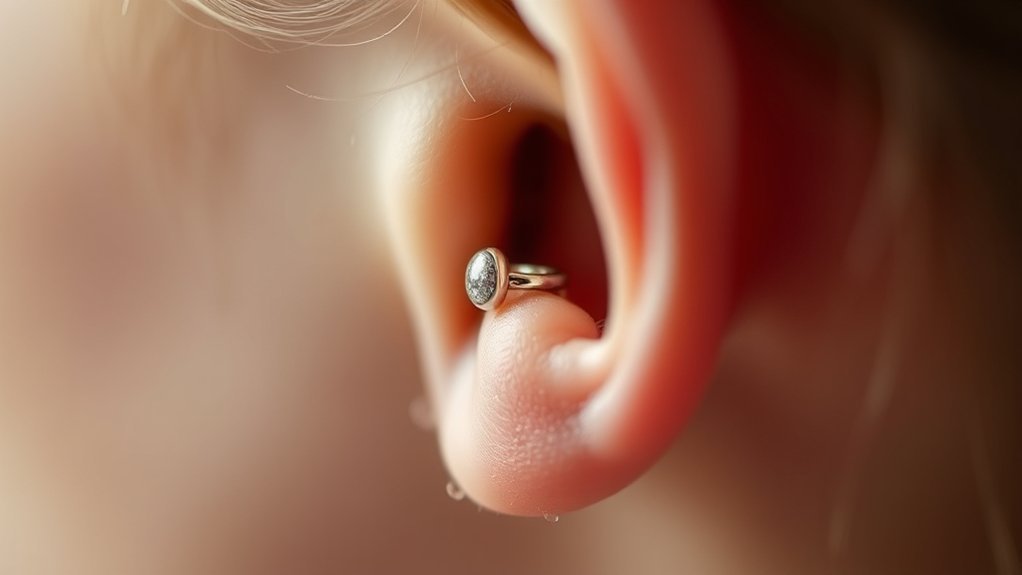When you get your ears pierced, understanding the potential signs of infection is essential for your health. You’ll want to monitor for symptoms like redness, swelling, and pain around the piercing. These indicators can signal a minor infection that needs attention. Knowing how to treat and prevent these issues is significant. So, what should you watch for, and how can you protect yourself? Let’s explore these important aspects.
Symptoms of Minor Ear Infection
When you’re dealing with a minor ear infection after getting your ears pierced, you might notice several symptoms at the site of the earring.
Common symptoms include redness, swelling, pain, and crusting around the infected area. These signs can occur soon after the piercing or develop later if you haven’t maintained proper care.
Common symptoms of a minor ear infection include redness, swelling, pain, and crusting around the piercing site.
While mild infections often resolve with appropriate home treatment within 1 to 2 weeks, it’s vital to monitor the healing process closely.
If you notice persistent or worsening symptoms, such as spreading redness or increased pain, seek medical attention immediately to prevent complications.
Regular cleaning and attentive care are essential for healing and minimizing the risk of further infection.
Causes of Infections in Newly Pierced Ears
Infections in newly pierced ears can occur due to several factors, primarily related to hygiene and care practices. To minimize the risk of infections, consider the following:
- Always use sterile tools and earrings during the piercing process to prevent bacteria introduction.
- Maintain daily cleaning of your earlobes; inadequate hygiene can lead to infections.
- Avoid touching earrings with unwashed hands, as this introduces harmful bacteria.
Additionally, be mindful of tight earring backs; they can impede blood flow and increase irritation.
Removing earrings before the healing process, which typically takes around six weeks, can disrupt healing and lead to infection.
Causes of Infections After Healing
Even after your ear piercing has healed, infections can still occur due to several factors.
Infrequent cleaning of earrings and posts allows bacteria to build up, increasing the risk of infections. Touching your earrings with dirty hands can introduce pathogens into the ear canal.
Tight earring backs may cause pressure and irritation on the earlobe, heightening infection likelihood. Additionally, not removing earrings at night exposes them to moisture and bacteria, which can contribute to infection risk.
Scratches or tears in the ear channel caused by heavy earrings or improper post angles create entry points for bacteria.
Be mindful of these factors to minimize symptoms and maintain healthy piercings.
Treatment for Minor Infections
If you’re dealing with a minor ear infection, taking the right steps can make a significant difference in your recovery.
First, don’t remove the earring, as this can lead to further irritation. Instead, focus on these key actions:
- Clean the infected area three times daily using a specialized pierced ear solution.
- Apply antibiotic ointment, like Polysporin, after cleaning to combat the infection.
- Monitor symptoms closely; if you notice persistent redness and swelling, seek medical advice.
Continue these steps until symptoms resolve for at least two days, ensuring full healing and preventing recurrence.
Prevention of Infections in Pierced Ears
To keep your newly pierced ears healthy and free from infections, it’s crucial to follow a few key preventive measures.
First, avoid removing your earrings for the first six weeks to allow proper healing. Always wash your hands before touching your ears or earrings to minimize bacteria exposure.
Clean your earlobes and earrings twice daily with a specialized solution to maintain hygiene and reduce infection risk. Verify that earring backs aren’t too tight, as this promotes blood flow and prevents irritation.
Additionally, consider taking out your earrings at night to expose the piercing to air, which aids in healing and reduces moisture accumulation.
If you notice any symptoms of infections, apply an antibiotic ointment as a precaution.
Frequently Asked Questions
What Is the 3 2 Rule for Piercings?
The “3 2 Rule” for piercings means you should clean the area three times a day for the first two weeks. This routine helps prevent infection and promotes healing around your new piercing.
When to Be Concerned About an Ear Piercing?
You should be concerned about an ear piercing if you notice spreading redness, increasing swelling, persistent pain, fever, or any signs of an allergic reaction. Consult a healthcare provider if symptoms worsen or don’t improve within two weeks.
What Are the First Signs of an Infected Ear Piercing?
You might notice a fiery redness, swelling like a balloon, and a sting near your new piercing. If you see crusting or feel warmth, it’s time to pay attention and consider seeking medical advice.
How Do I Know if My Ear Piercing Is Healing Properly?
You’ll know your ear piercing is healing properly if redness and swelling decrease, tenderness lessens, and discharge stops. Look for skin tightening around the jewelry and remember to clean it regularly to promote healing.
Conclusion
To summarize, just like a garden needs care to flourish, your newly pierced ears require attention to prevent infections. By recognizing symptoms like redness and swelling early, you can address potential issues before they escalate. Following proper treatment and prevention strategies will help keep your ears healthy and guarantee your piercings remain a source of pride, not pain. Remember, a little diligence now can save you from bigger problems later on.
